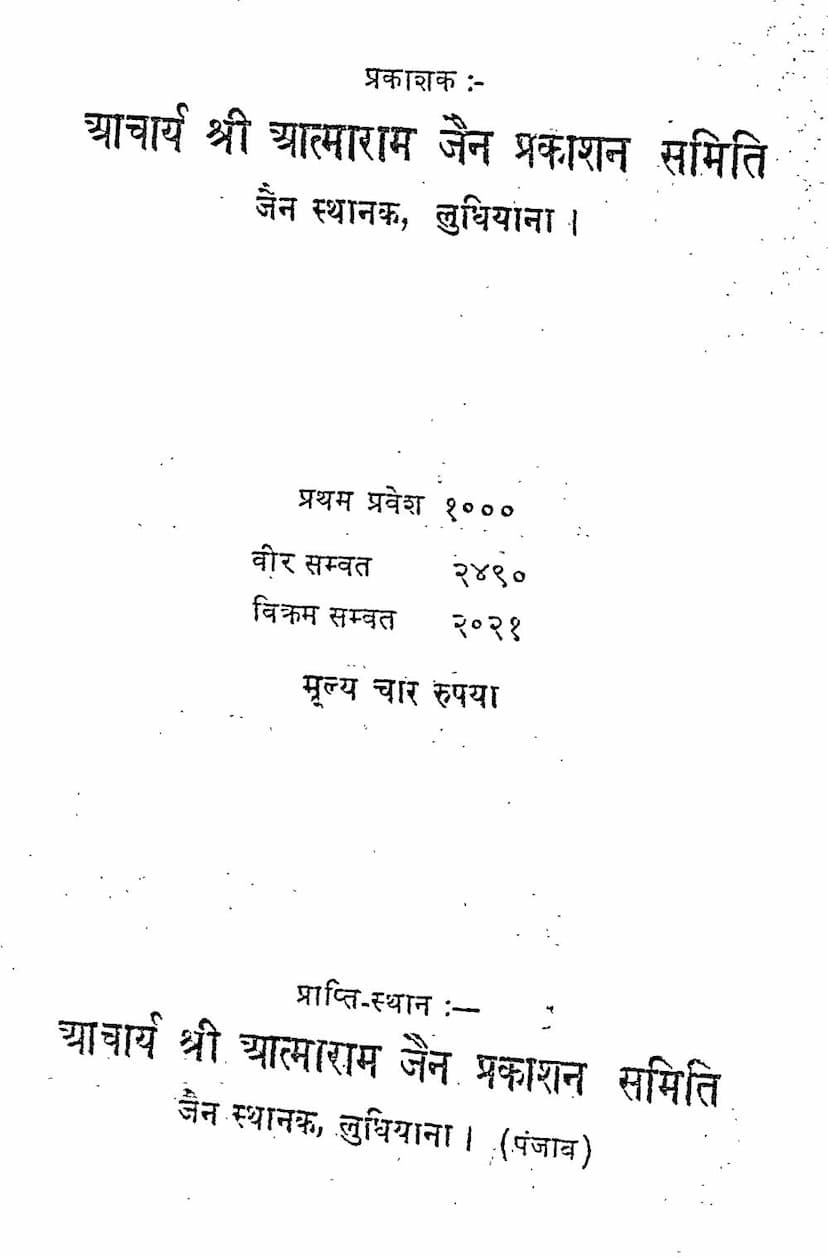Prashno Ke Uttar Part 2
Added to library: September 2, 2025

Summary
The book "Prashno Ke Uttar Part 2" (Answers to Questions, Part 2) by Atmaramji Maharaj, published by Atmaram Jain Prakashan Samiti, is a comprehensive exploration of various aspects of Jain philosophy and practice. It aims to provide answers to questions that arise in the minds of devotees and seekers of truth, particularly within the Sthanakvasi Jain tradition.
Key Themes and Content:
The book is structured into eighteen chapters, each delving into specific topics related to Jainism. Here's a summary of the major themes covered, based on the provided table of contents:
-
Ethical Conduct and Virtues (Chapters 10-13):
- Seven Deadly Sins (Sapt Kubyasan Parityag): Chapter 10 focuses on the abandonment of seven major vices: gambling, meat-eating, drinking, prostitution, hunting, theft, and adultery. It elaborates on the detrimental effects of each and why they are forbidden in Jainism.
- Layperson's Path (Aagar Dharm): Chapter 11 outlines the ethical duties and vows for Jain householders. It discusses how laypeople can practice Jain principles within their daily lives, covering vows like non-violence (Ahimsa), truthfulness (Satya), non-stealing (Asteya), celibacy/chastity (Brahmacharya), and non-possession (Parigrah Pariman). It also touches upon concepts like regulating consumption and the importance of ethical conduct in livelihood (Karmaadan, Anarthdand Viraman).
- Ascetic's Path (Angaar Dharm): Chapter 12 details the stricter path of Jain monks and nuns, emphasizing vows like complete non-violence, truth, non-stealing, absolute celibacy, and complete non-possession. It delves into practices like the five restraints (Samiti), three safeguards (Gupti), and the use of monastic implements like the Rakchharan (broom) and Mukhavastrika (mouth cloth).
- The Twenty-Four Tirthankaras (Choubees Tirthankar): Chapter 13 provides information about the lives and teachings of the twenty-four Tirthankaras, considered the spiritual guides and founders of Jainism. It discusses their significance, their birth stories, and their lifespan.
-
Jain Sects and Practices (Chapters 14-16):
- Sthanakvasi and Other Jain Sects: Chapter 14 explores the Sthanakvasi tradition and its relationship with other Jain sects, likely discussing their distinct practices and beliefs. It also addresses the historical development and origins of different Jain traditions.
- Jain Festivals (Jain Parva): Chapter 15 highlights the importance and significance of various Jain festivals like Akshay Tritiya, Paryushan, Samvatsari, and Parshva Jayanti, explaining their religious and cultural context.
- Devotional Worship (Bhav Pooja): Chapter 16 contrasts devotional practices, specifically discussing the Sthanakvasi perspective on idol worship versus internal devotion (Bhav Pooja). It emphasizes the importance of inner spiritual practice over external rituals.
-
Jainism and Worldly Issues (Chapters 17-18):
- Jainism and World Problems: Chapter 17 examines how Jain principles, particularly non-violence (Ahimsa), can offer solutions to contemporary global issues like conflict, environmental concerns, and social disharmony. It suggests Jainism's relevance in promoting peace and understanding.
- Nature of the Universe (Lok-Swaroop): Chapter 18 delves into the Jain cosmological view, describing the structure of the universe, including different realms, celestial bodies (sun, moon, stars), and the concept of time cycles (Avasarpini and Utsarpini Kal). It also discusses the geographical descriptions of the Jain universe, like Jambudvipa and the oceans.
Key Focus Areas within the Chapters:
- Non-Violence (Ahimsa): This is a central theme throughout the book, explored in various contexts, from the vows of monks and nuns to the ethical considerations for laypeople and its application to global problems. The distinction between violence in intention (Sankalpi) and unavoidable violence in daily life (Aarambhi, Udyogi) is likely discussed.
- Karma and Rebirth: The text implicitly or explicitly addresses the Jain doctrine of karma, explaining how actions lead to consequences and influence rebirth.
- Spiritual Development: The book guides readers on the path of spiritual progress, emphasizing the importance of ethical conduct, self-control, and detachment for liberation.
- Comparative Religion: While focused on Jainism, the text might offer comparative insights, especially when discussing ethical principles or historical contexts.
- The Sthanakvasi Tradition: Given the publisher and author's likely affiliation, there's a strong focus on explaining and upholding the beliefs and practices of the Sthanakvasi sect, including their non-adherence to idol worship and their emphasis on internal spiritual practices.
Overall Purpose:
"Prashno Ke Uttar Part 2" serves as an educational resource for Jains, offering clear explanations and justifications for the tenets of their faith. It aims to deepen understanding of Jain philosophy, ethics, and practices, encouraging readers to live a more virtuous and spiritually fulfilling life. The book's comprehensive nature suggests it's intended to be a foundational text for those seeking to understand Jainism in depth.